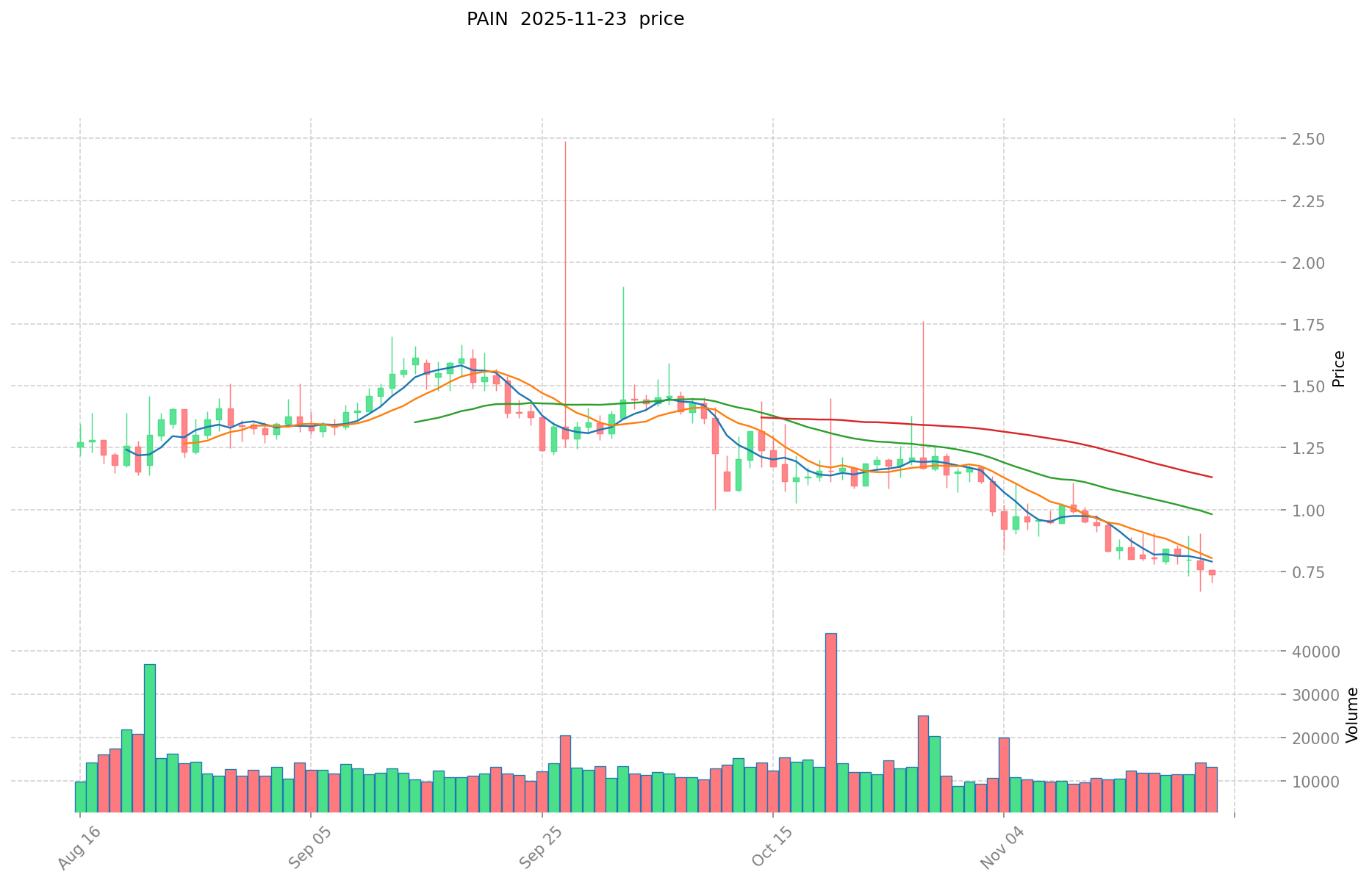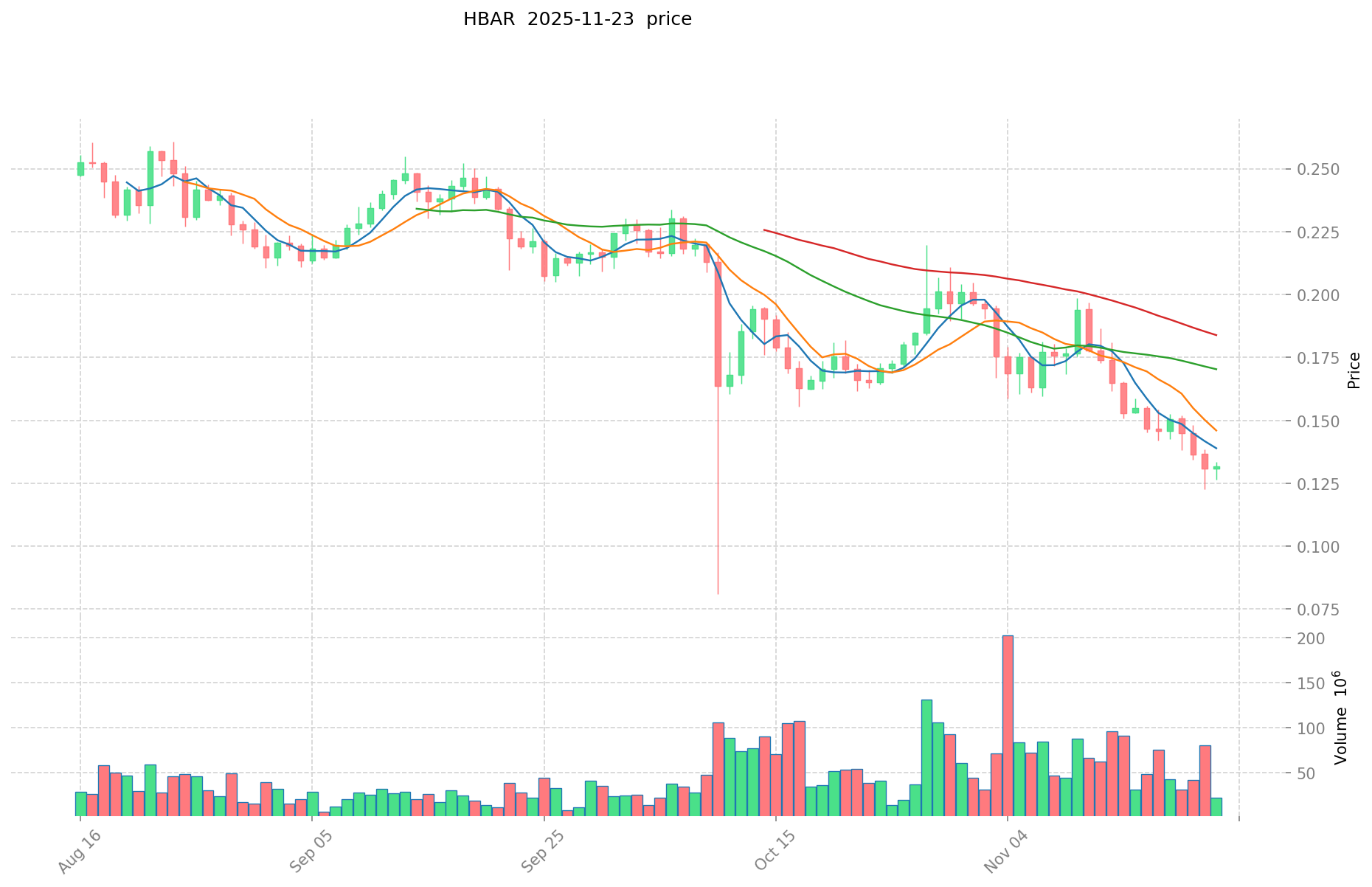PAIN vs HBAR: The Battle of Blockchain Solutions for Enterprise Adoption
Introduction: Investment Comparison of PAIN vs HBAR
In the cryptocurrency market, the comparison between PAIN vs HBAR has been an unavoidable topic for investors. The two not only show significant differences in market cap ranking, application scenarios, and price performance, but also represent different crypto asset positioning.
PAIN (PAIN): Launched as the official memecoin of the OG meme legend "Hide the Pain Harold", it aims to function as an expression of pain on the blockchain.
HBAR (HBAR): Since its launch in 2019, it has been recognized for its fast, secure, and fair public ledger network using hashgraph consensus.
This article will provide a comprehensive analysis of the investment value comparison between PAIN vs HBAR, focusing on historical price trends, supply mechanisms, institutional adoption, technological ecosystems, and future predictions, attempting to answer the question investors are most concerned about:
"Which is the better buy right now?"
I. Price History Comparison and Current Market Status
PAIN (Coin A) and HBAR (Coin B) Historical Price Trends
- 2025: PAIN reached its all-time high of $22.5 on February 20, 2025, and subsequently declined to its all-time low of $0.6685 on November 21, 2025.
- 2021: HBAR hit its all-time high of $0.569229 on September 15, 2021, following significant market momentum.
- Comparative Analysis: PAIN, being a newer token, has shown extreme volatility in 2025, while HBAR has maintained a more stable long-term trajectory since its 2020 low of $0.00986111.
Current Market Situation (2025-11-24)
- PAIN current price: $0.7702
- HBAR current price: $0.15057
- 24-hour trading volume: PAIN $9,849.24 vs HBAR $7,445,969.61
- Market Sentiment Index (Fear & Greed Index): 13 (Extreme Fear)
Click to view real-time prices:
- Check PAIN current price Market Price
- Check HBAR current price Market Price


II. Core Factors Affecting PAIN vs HBAR Investment Value
Supply Mechanism Comparison (Tokenomics)
- PAIN: Fixed supply with a maximum cap, creating scarcity as adoption increases
- HBAR: Time-released supply schedule with tokens gradually entering circulation based on network growth
- 📌 Historical pattern: Fixed supply tokens like PAIN typically experience more pronounced price volatility during market cycles, while HBAR's controlled release aims to reduce extreme price fluctuations.
Institutional Adoption and Market Applications
- Institutional holdings: HBAR shows stronger institutional interest through the Hedera Governing Council that includes Google, IBM, and other major corporations
- Enterprise adoption: HBAR has gained traction in enterprise applications for supply chain, identity verification, and tokenization, while PAIN is positioning itself in the DeFi and trading spaces
- Regulatory stance: HBAR benefits from regulatory clarity through its governing council structure, while PAIN faces varying regulatory approaches across jurisdictions
Technical Development and Ecosystem Building
- PAIN technical upgrades: Focus on enhanced security features and trading functionality
- HBAR technical development: Ongoing implementation of sharding and smart contracts to improve scalability and support enterprise applications
- Ecosystem comparison: HBAR has stronger enterprise applications, while PAIN shows growing presence in DeFi protocols and trading platforms
Macroeconomic Factors and Market Cycles
- Performance during inflation: HBAR's enterprise backing may provide more stability during inflationary periods, while PAIN's fixed supply model positions it as a potential inflation hedge
- Macroeconomic monetary policy: Both tokens show sensitivity to interest rate changes, with PAIN typically displaying higher correlation to risk-on assets
- Geopolitical factors: HBAR's enterprise governance structure may provide advantages for cross-border settlement use cases, while PAIN benefits from decentralization during periods of geopolitical uncertainty
III. 2025-2030 Price Prediction: PAIN vs HBAR
Short-term Prediction (2025)
- PAIN: Conservative $0.44 - $0.77 | Optimistic $0.77 - $1.06
- HBAR: Conservative $0.11 - $0.15 | Optimistic $0.15 - $0.16
Mid-term Prediction (2027)
- PAIN may enter a growth phase, expected price range $0.51 - $1.27
- HBAR may enter a moderate growth phase, expected price range $0.11 - $0.22
- Key drivers: Institutional capital inflow, ETF, ecosystem development
Long-term Prediction (2030)
- PAIN: Base scenario $1.39 - $1.70 | Optimistic scenario $1.70+
- HBAR: Base scenario $0.25 - $0.33 | Optimistic scenario $0.33+
Disclaimer: This analysis is for informational purposes only and should not be considered as financial advice. Cryptocurrency markets are highly volatile and unpredictable. Always conduct your own research before making any investment decisions.
PAIN:
| 年份 | 预测最高价 | 预测平均价格 | 预测最低价 | 涨跌幅 |
|---|---|---|---|---|
| 2025 | 1.055174 | 0.7702 | 0.439014 | 0 |
| 2026 | 1.10435127 | 0.912687 | 0.73927647 | 18 |
| 2027 | 1.2707341101 | 1.008519135 | 0.51434475885 | 30 |
| 2028 | 1.6068735377955 | 1.13962662255 | 0.6723797073045 | 47 |
| 2029 | 1.414447582577932 | 1.37325008017275 | 1.0986000641382 | 78 |
| 2030 | 1.700495574277916 | 1.393848831375341 | 1.296279413179067 | 80 |
HBAR:
| 年份 | 预测最高价 | 预测平均价格 | 预测最低价 | 涨跌幅 |
|---|---|---|---|---|
| 2025 | 0.1617624 | 0.14978 | 0.1063438 | 0 |
| 2026 | 0.200944848 | 0.1557712 | 0.115270688 | 3 |
| 2027 | 0.22294753 | 0.178358024 | 0.10879839464 | 18 |
| 2028 | 0.22874416578 | 0.200652777 | 0.12440472174 | 33 |
| 2029 | 0.2834019822348 | 0.21469847139 | 0.1588768688286 | 42 |
| 2030 | 0.326255797124244 | 0.2490502268124 | 0.189278172377424 | 65 |
IV. Investment Strategy Comparison: PAIN vs HBAR
Long-term vs Short-term Investment Strategy
- PAIN: Suitable for investors focused on meme coin potential and high-risk, high-reward opportunities
- HBAR: Suitable for investors seeking enterprise adoption and long-term technological value
Risk Management and Asset Allocation
- Conservative investors: PAIN: 5% vs HBAR: 15%
- Aggressive investors: PAIN: 15% vs HBAR: 25%
- Hedging tools: Stablecoin allocation, options, cross-currency portfolio
V. Potential Risk Comparison
Market Risk
- PAIN: High volatility due to meme coin status and speculative nature
- HBAR: Potential market saturation in enterprise blockchain solutions
Technical Risk
- PAIN: Network scalability, smart contract vulnerabilities
- HBAR: Centralization concerns, potential bugs in hashgraph consensus
Regulatory Risk
- Global regulatory policies may have different impacts on both tokens, with HBAR potentially facing less scrutiny due to its enterprise governance structure
VI. Conclusion: Which Is the Better Buy?
📌 Investment Value Summary:
- PAIN advantages: High growth potential, fixed supply, meme coin appeal
- HBAR advantages: Enterprise adoption, established use cases, regulatory clarity
✅ Investment Advice:
- New investors: Consider a small allocation to HBAR for exposure to enterprise blockchain
- Experienced investors: Balanced approach with both PAIN and HBAR based on risk tolerance
- Institutional investors: Focus on HBAR due to its enterprise connections and regulatory clarity
⚠️ Risk Warning: Cryptocurrency markets are highly volatile. This article does not constitute investment advice. None
VII. FAQ
Q1: What are the main differences between PAIN and HBAR? A: PAIN is a meme coin with a fixed supply, while HBAR is an enterprise-focused cryptocurrency with a time-released supply schedule. PAIN is more volatile and speculative, whereas HBAR has stronger institutional adoption and established use cases in enterprise applications.
Q2: Which cryptocurrency has shown better price performance recently? A: As of November 24, 2025, PAIN is trading at $0.7702, while HBAR is at $0.15057. PAIN has experienced more extreme price movements, reaching an all-time high of $22.5 in February 2025 before declining significantly. HBAR has maintained a more stable long-term trajectory since its 2020 low.
Q3: How do the supply mechanisms of PAIN and HBAR differ? A: PAIN has a fixed supply with a maximum cap, creating scarcity as adoption increases. HBAR uses a time-released supply schedule, with tokens gradually entering circulation based on network growth. This difference in tokenomics can affect price volatility and long-term value proposition.
Q4: Which cryptocurrency is more suitable for institutional investors? A: HBAR is generally more suitable for institutional investors due to its enterprise connections through the Hedera Governing Council, which includes major corporations like Google and IBM. It also benefits from greater regulatory clarity, making it a potentially safer choice for institutional portfolios.
Q5: What are the predicted price ranges for PAIN and HBAR in 2030? A: For PAIN, the base scenario predicts a price range of $1.39 - $1.70, with an optimistic scenario of $1.70+. For HBAR, the base scenario predicts a price range of $0.25 - $0.33, with an optimistic scenario of $0.33+. However, these predictions are speculative and subject to market conditions.
Q6: How should investors approach risk management when investing in PAIN and HBAR? A: Conservative investors might consider allocating 5% to PAIN and 15% to HBAR, while aggressive investors might allocate 15% to PAIN and 25% to HBAR. It's important to use hedging tools such as stablecoin allocation, options, and maintaining a diversified cross-currency portfolio to manage risk.
Q7: What are the key factors that could affect the future value of PAIN and HBAR? A: Key factors include institutional adoption, regulatory developments, technological advancements, market cycles, and macroeconomic conditions. For PAIN, meme coin trends and community engagement are crucial, while for HBAR, enterprise application growth and hashgraph technology development are important factors to watch.
Share
Content